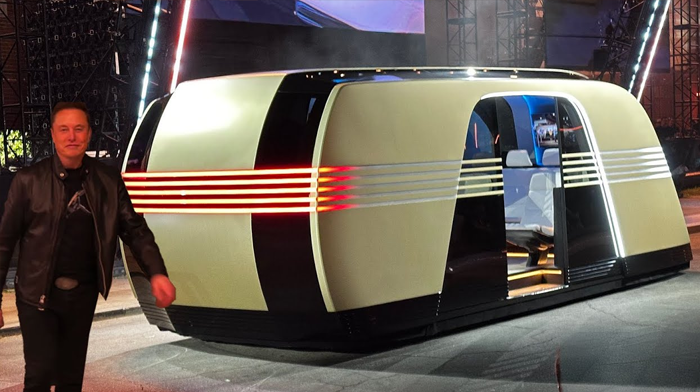During Tesla’s highly anticipated “We, Robot” event, the spotlight was primarily on the futuristic Robotaxi. However, CEO Elon Musk took the audience even further into Tesla’s vision of autonomous transport with the introduction of a bold new concept—the Robovan. This vehicle isn’t just another electric van; it’s a fully autonomous, multi-purpose transporter designed to change how we think about mass transit and personal transportation.
Robovan or Robobus?
At first glance, the name “Robovan” might suggest a standard-sized van, but what Tesla revealed looked more like a futuristic bus—or even a train car. Its oversized, boxy design immediately stood out, drawing comparisons to retro locomotives with a modern twist. Elon Musk, speaking to a select group of attendees, made it clear that what was shown would closely resemble the final product. “We’re going to make this, and it’s going to look like that,” he confidently stated.
Like the Robotaxi, the Robovan lacks a steering wheel or pedals, relying entirely on Tesla’s advanced autonomous driving system. The spacious interior resembles a cozy lounge, with mood lighting and wide seating arrangements. Photos shared by Tesla show rows of seats facing each other, reminiscent of a communal waiting room—but in a far more elegant, high-tech environment.
The Robovan can transport up to 20 passengers at a time, making it ideal for both personal and commercial applications. With large glass panels running along both sides of the roof and a sleek sliding door that adds a touch of transparency, the Robovan seems designed to provide passengers with both comfort and a modern transportation experience.
Adaptability for Personal and Commercial Use
One of the most exciting aspects of the Robovan is its flexibility. Musk hinted that the vehicle could be tailored for various needs, whether for public transportation, private ownership, or even delivery services. This versatility could make the Robovan an integral part of cities’ transportation infrastructures, helping alleviate congestion while reducing carbon footprints.
Although Tesla didn’t provide many details about the Robovan’s technical specs, the concept certainly positions the vehicle as a practical solution for large groups or cargo transportation. The possibility of using it for personal travel is intriguing, but Musk’s suggestion of commercial use opens the door for future fleet operations by businesses or public transit systems.
Production Timeline and Regulatory Challenges
While the Robovan dazzled those in attendance, one crucial element was missing—any mention of pricing or a concrete production timeline. Musk remained vague, stating only that the company plans to manufacture the Robovan, though he admitted the timeline for production will likely be after 2026. Considering the Robotaxi, a smaller, similarly autonomous vehicle, isn’t expected to enter production until 2026, the Robovan might not hit the streets until at least 2027.
Tesla’s optimistic projections are well-known, with Musk himself acknowledging during the event, “I tend to be a little optimistic with time frames.” While Tesla’s development pace is rapid, the company must also secure regulatory approval for its Full Self-Driving (FSD) software to operate without supervision. The FSD system is the backbone of all Tesla’s autonomous vehicle plans, including both the Robotaxi and Robovan, and its legal clearance will be critical to the company’s vision of an autonomous transportation network.
Full Autonomy: The Future of Tesla’s Fleet
The Robovan fits perfectly into Tesla’s larger vision of a fully autonomous future. As part of this plan, Musk envisions fleets of autonomous vehicles—from compact Robotaxis to spacious Robovans—operating efficiently and safely, without the need for human drivers. The key to achieving this future lies in perfecting and certifying Tesla’s FSD technology, which is still under development and requires substantial regulatory approval before widespread deployment.
If Tesla’s FSD software achieves its goal of true autonomy, vehicles like the Robovan could dramatically reduce the need for traditional, driver-operated mass transit. City planners and businesses alike would likely be eager to incorporate such a versatile, autonomous vehicle into their infrastructures, potentially transforming urban mobility.
Conclusion: A Vision Beyond the Van
The Robovan, while still in its concept stage, represents another bold step in Tesla’s quest to revolutionize transportation. With its futuristic design, autonomous capabilities, and adaptable nature, it has the potential to be much more than just a van—becoming a critical component of both public and private transport in the years to come.
Though no specific production date or price has been announced, and regulatory hurdles remain, Tesla’s track record of pushing technological boundaries suggests that the Robovan will eventually become a reality. As Tesla continues to refine its autonomous technology, vehicles like the Robovan offer a glimpse of how transportation may evolve in the not-so-distant future.
